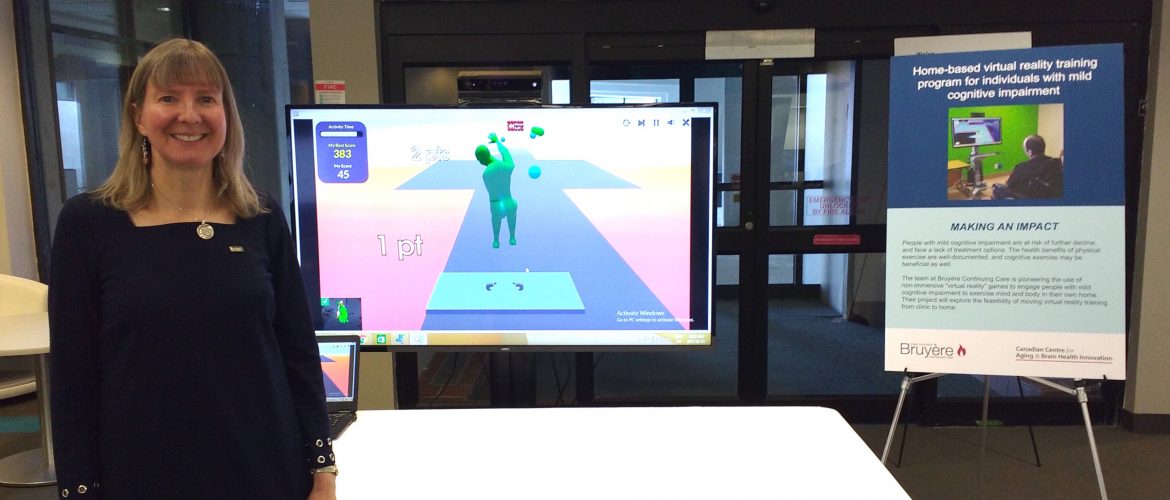Fitness video games—think Wii Fit or Dance Dance Revolution—are commonly associated with adolescents. These exercise programs (also called exergames) use virtual reality software to track body movements, allowing a user to interact with the activity presented on a TV screen.
Could exergaming be used to benefit older adults with cognitive impairment? One CABHI-funded research group is on its way to finding out.
Physical medicine and rehabilitation physician Dr. Hillel Finestone and physiotherapist Dr. Lisa Sheehy are part of a multidisciplinary team at Ottawa’s Bruyère Continuing Care that’s been pioneering the use of exergaming on stroke rehabilitation patients for a decade.
Recently the team turned their attention another population: seniors with Mild Cognitive Impairment (MCI). Those with MCI experience minor problems with cognitive functions like memory or thinking, and are considered at risk of developing dementia. It’s estimated that half a million Canadians over the age of 65 live with the condition.
“Seniors with MCI are suggested by their physicians to incorporate exercise as part of a healthy lifestyle,” says Dr. Sheehy. “Physical exercise has potential to improve or stabilize MCI, and the combination of physical and cognitive exercise may be even better.”
But there are often barriers preventing seniors from participating in regular exercise classes. Mobility issues, difficulty arranging transportation, fear of falling, prohibitive cost, or bad weather could all prevent attendance.
Enter exergaming. It’s unorthodox—but it might be the home-based solution many seniors are looking for.
Dispelling misconceptions about seniors and technology
Thanks to support from the Centre for Aging + Brain Health Innovation (CABHI), Drs. Finestone and Sheehy’s project leveraged $50,000 in funding from the Spark program to develop and test an exergame training program tailored for seniors with MCI.
Their team recruited a group of 12 older adults with MCI ranging in physical and cognitive ability. Participants were asked to follow the virtual reality training program in their own homes for 30 minutes a day, five days a week over six consecutive weeks. Activities focused on balance, arm and leg exercises, gentle aerobic conditioning, and cognition. The exergaming technology was connected to a TV—which most participants already owned—and set up in whatever room the participants chose.
To the team’s surprise, participant compliance was excellent.
“The first several participants were averaging 30.5 minutes per session, at an average of 31 sessions over six weeks—more than what we asked,” says Dr. Sheehy. “I think that’s amazing. People were very engaged and motivated.”
She reports that participants’ perceived physical benefit correlated to their pre-existing abilities—meaning participants who felt they benefitted most were the ones that hadn’t been active beforehand.
One participant, Rick, says he felt the program helped him improve physically. “In fact, Dr. Sheehy increased the difficulty of the different exercises several times during the six weeks because they got easier for me,” he says.
Rick also feels the improvement translated into daily physical actions like bending down to the floor and getting back up again.
Perhaps most importantly, the study answered some fundamental questions about usability. All participants were able to handle the technology—turn the computer on and off, move the mouse—as well as learn and progress through the training program.
“There’s an automatic assumption many people have that seniors will have difficulty with computers and technology,” Dr. Finestone says. “From our work, we can say no, that’s not true. If the system is simple enough, technology is not an impediment to the performance of the training program.”

Dr. Hillel Finestone
Bringing exergaming for seniors to the mainstream
The training program could be uniquely viable for a commercial audience of seniors that crosses socioeconomic lines. The program functions on common household amenities like an internet connection and a TV, and its virtual reality hardware was chosen specifically because it’s inexpensive and already available on the market. Several study participants have expressed interest in purchasing the program.
That’s the future Drs. Finestone and Sheehy envision. They hope to see home-based exergaming technology reach a mainstream audience of seniors, as well as spread into settings like outpatient rehabilitation—where physiotherapists and occupational therapists could facilitate continued targeted therapy outside of appointments.
The pair plan to follow this study with another, longer one that focuses further on increasing cognitive benefit in addition to physical. CABHI’s support has opened the doors to future testing, says Dr. Finestone.
“This is an example of CABHI enabling a research group to really exercise their thoughts and their dreams,” he says.
“What I’ve been so impressed by is CABHI’s recognition that there is a science behind science, and that questions about implementation and feasibility are just as important as the science itself. It’s not a given that seniors with a cognitive impairment are going to be able to uptake technology like this. But CABHI has enabled us to do the work to say yes, they can.”


